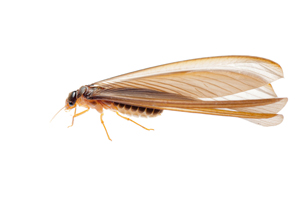 Termites cause billions of dollars in damage each year to homes across the U.S.
Termites cause billions of dollars in damage each year to homes across the U.S.
They’re a nuisance to your health, your house, and your property value and getting rid of these pesky invaders is harder than it seems. In fact, termite treatment is one of the most-requested professional pest services in the country and in many cases, homeowners could have saved themselves time and money by turning to professionals first.
If you’ve noticed termites or signs of damage in your home, what should you do? And how does termite treatment work?
Termite Treatment Starts with Identification
The first step in treating a termite issue is first identifying the problem and figuring out which type of termites you’re dealing with. There are three primary types of termites in the U.S.:

Drywood termites live in colder climates, fly in swarms, and eat any dry wood source they can find.
Dampwood termites only eat moist wood so they’re more often found outdoors than inside homes.
Signs of a termite infestation typically include finding wood shavings, noticing small holes in walls or framing, and even seeing skeletons or wing remnants of termites in your property. The bad news is, by the time you see evidence of termites the infestation is often way out of hand.
Getting Started With Termite Treatment
If you wish to try and treat your termite problem without professional intervention you should realize you’re taking a big risk. Termites are master hiders and it’s often difficult to fully eradicate them without careful, consistent treatment. Many hardware stores sell over-the-counter termite bait stations and sprays, all of which have varying degrees of effectiveness.
Professional termite experts provide the best chance at nipping your infestation in the bud. They’re trained to find exactly where colonies are based, identify the queen, and even in the intricacies of construction that may invite colonization. There are several different termite treatment methods used regularly among pest professionals.
Bait Systems
Bait systems are designed to lure termites away from your property with a control agent that’s meant to kill off the colony. The bait stations are placed around your property and the agent is carried back to the nest by worker termites who believe it to be food. This method is often used when a moderate termite infestation has already been detected in the home.
Liquid and Foam Sprays
From a preventative standpoint, liquid and/or foam applications often make the most sense. An exterminator treats the perimeter of your home with a liquid or foaming control agent which kills termites on contact, stopping them from ever entering your property in the first place. It’s particularly effective at controlling subterranean termite infestations.
Fumigation
In cases of serious termite infestation, particularly when drywood termites are involved, fumigation (or “tenting”) may be necessary to fully rid your home of pests. Since drywood termites can live in furniture, walls, and even your attic, exterminators may need to tent your entire property then use a fumigant that penetrates all wood surfaces in the home, killing all pests. These treatments are specially designed to leave no residue behind, but they’re often the most inconvenient.

- Physical or sand barriers are sometimes erected outside the home
- Microwave treatments are gaining in popularity
- Infrared cameras are being seen in some markets for termite detection
Your termite professional can talk you through the best choice for your home and help you decide which treatment’s right for your family. One thing’s for sure: the sooner you deal with termites, the less damage and hassle you’ll have to deal with later. One in thirty U.S. homes is infested with termites each year. Don’t let yours be one of them.

